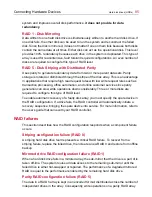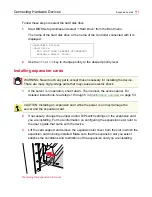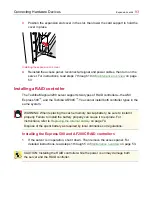
Connecting Hardware Devices
Hard disk drives (HDDs)
85
system and improves overall disk performance, it does not provide for data
redundancy.
RAID 1 - Disk Mirroring
Data written to one hard disk drive is simultaneously written to another hard disk drive. If
one disk fails, the other disk can be used to run the system and reconstruct the failed
disk. Since the disk is mirrored, it does not matter if one on them fails because both disks
contain the same data at all times. Either disk can act as the operational disk. This level
provides 100% redundancy because each drive in the system is duplicated. This type of
array is used for read-intensive, fault tolerant required configurations. An even number of
disks are required to configure this type of RAID level.
RAID 5 - Disk Striping with Distributed Parity
Uses parity to generate redundancy data from two or more parent data sets. Parity
storage is rotated or distributed through the stripe of the disk array. This is an advantage
in applications that require high read request rates with low write request rates such as
transaction processing, office automation, and online customer service since parity
generation can slow write operations down considerably. Three or more disks are
required to configure this type of RAID level.
To enable automatic recovery of a faulty disk array, you must specify the spare device in
the RAID configuration. If a drive fails, the RAID controller will automatically initiate a
recovery sequence, bringing the spare device into service. For more information, refer to
the user’s guide that came with your RAID controller.
RAID failures
This section describes how the RAID configuration responds when a component failure
occurs.
Striping configuration failure (RAID 0)
A striping hard disk drive fault represents a critical RAID failure. To recover from a
striping failure, replace the failed drive, then create a new RAID 0 and restore from offline
backup.
Mirrored drive RAID configuration failure (RAID 1)
When a hard disk drive fails in a mirrored array, the sub-mirror that the drive is a part of is
taken off-line. The system routes all data access to the remaining sub-mirror until the
failed drive is either hot-swapped or repaired. The performance of a degraded mirrored
RAID is equal to the performance rendered by the remaining hard disk drive.
Parity RAID configuration failure (RAID 5)
The data in a RAID 5 array is kept in an encoded format, distributed across the number of
independent drives in the array. Consequently, write operations on a parity RAID array
Summary of Contents for 3200
Page 1: ... ...
Page 309: ...309 ...
















































